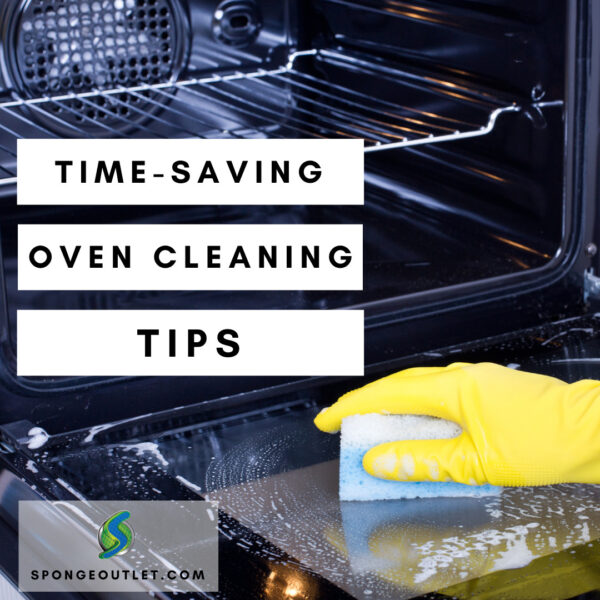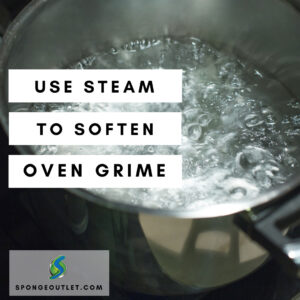
Saving time cleaning does not always mean cutting corners, sometimes it means cleaning wisely, or prepping the area before you clean to save time later. Here’s how to clean a kitchen oven quickly.
Save Time Oven Cleaning Tip: First, Check What the Oven Manufacturer Recommends
Most major appliance manufacturers have websites that include the care and cleaning of their appliances. Find out your client’s appliance brand ahead of time and check the website for the best way to clean their oven. You can even ask for a model or serial number located on the appliance and enter this information into the website to pull up a PDF copy of the oven’s owner’s manual.
Save Time Oven Cleaning Tip: Cover the Floor Around the Oven and Oven Door
All that greasy grime from inside the oven can spill over the door and drip in-between cracks, leaving a messy floor that you now need to clean. Avoid this by placing either a plastic garbage bags or an old towel to protect the floor.
Save Time Oven Cleaning Tip: Remove the Warming Drawer
Dirty and greasy water drips can easily fall into the bottom warming drawer leaving a mess. Now you need to spend more time cleaning this too. If you feel comfortable, remove the warming drawer, or else lay a towel or plastic garbage bag over the top of the drawer to protect it from falling dirt and grime.
Save Time Oven Cleaning Tip: Clean the Racks Inside a Garbage Bag
Remove the oven racks and place them in a draw-string garbage bag. Add your cleaner to the racks and let them marinate in the cleaner while you focus on cleaning the oven. Remove the racks and wipe them clean with a wet sponge or microfiber cloth. Toss the dirty bag and you are done!
Save Time Oven Cleaning Tip: Use a Vacuum
Save time by vacuuming up any crumbs or residue inside the oven first, before applying any cleaner or water.
 Save Time Tip: Use the Power of Steam to Soften Oven Grime
Save Time Tip: Use the Power of Steam to Soften Oven Grime
Either boil a pot of water on the stove top or pour cold water into a large oven-proof pot or casserole dish and turn the oven on to boil it. Some people like to add either lemons or vinegar for added cleaning power to the steam. The hot steam will soften any stuck-on food splatter or grease insides the oven, making it easier to wipe off.
Make your Own DIY Oven Cleaner
Mix together a paste of baking soda, dish washing liquid and a little water and leave it on the oven’s inside surfaces for 30 minutes. Use a spray bottle filled with vinegar or lemon juice to spray inside the oven for added cleaning power on tough grime and grease.
Remove any trace of your home-made cleaner with a damp non-scratch sponge or microfiber cleaning cloth. After the oven is clean, turn it on to make sure there is no smoking from left-over cleaner.
Save Time Oven Cleaning Tip: Clean Door Oven Glass with a Wet Pumice Stone
Clean exceptionally greasy and dirty oven door glass with a wet pumice stone.
Avoid Unhappy Customers with These Oven Cleaning Tips
Stick to a Non-Scratch Sponge
Use a non-scratch scrub sponge like our non-scratch Instant Eraser Super Star Scrubby Sponge or Monster Scrubby Scratch-Free Sponge on oven wall surfaces. Both sponges change texture according to water temperature, so try cooler water for a firmer sponge.
Only Clean a Cool or Cold Oven
If using a self-cleaning cycle, you will need to wait until the oven cools before being able to wipe away any ash or residue inside, so plan accordingly. You can also use a vacuum to vacuum up any remaining ash or residue, saving you time.
Get Approval Before Using the Self-Cleaning Cycle
Use caution when using the self-cleaning oven cycle. Check with the owner to see if it is safe to use as the self-cleaning cycle produces smoke and can also melt nearby cabinets as the temperatures it uses to clean are extremely high for long periods. This tip is courtesy of The Ugliest Cleaning Lady of Ft. Collins, Colorado.
Do not use the self-cleaning feature on an oven in a home with tropical birds. The fumes produced from the self-cleaning oven cycle may harm the birds.

 Save Time Tip: Use the Power of Steam to Soften Oven Grime
Save Time Tip: Use the Power of Steam to Soften Oven Grime